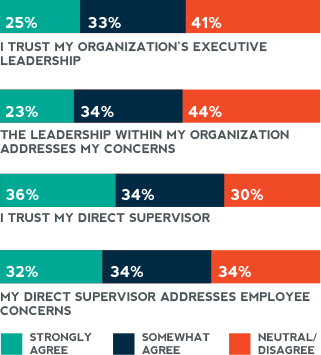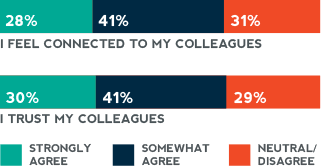Report
The business case for culture: How organizational culture impacts business performance

Related services and insights
Culture5 steps to improve employee connection and boost organizational performance
A survey of U.S. workers shows that according to employees, organizational culture has a significant impact on their commitment, job performance—and on their organization’s success.
In one of the tightest US job markets in the past two decades, executives across industries are deeply concerned about retaining employees. It is no wonder, because the impacts of losing top talent are far reaching. Financial losses multiply quickly—it costs up to 60 percent of employees’ annual salary to replace them if they leave, according to the Society for Human Resources Management. In addition, high turnover rates have a domino effect on the employees who remain—from lowering efficiency and productivity to negatively impacting morale—that drives more turnover.
Ending this vicious cycle takes more than office perks and salary adjustments in today’s competitive job market. Organizational culture is essential, and in many ways, it is the unsung hero of long-term organizational success. Not only is culture critical to retaining and attracting top talent, but it is also critical to other competitive advantages such as employee engagement and customer satisfaction—all of which are linked to organizational success.

Companies in the top quartile of employee engagement are 21% more profitable, 17% more productive, and experience nearly 60% less turnover.
Studies show that organizations with cultures that align closely to their mission are more successful. According to a Great Place to Work report, companies with great cultures have three times better stock market performance than those that do not. In fact, Eagle Hill Consulting believes that organizations can put a value on organizational culture, and we’ve set out on a journey to prove it. In this report, we describe the first steps in our Culture Valuation© journey to further explore workplace culture.
As part of this journey, we surveyed US workers across sectors to get a pulse on the state of organizational culture in the American workplace from the employee perspective. The results show that employees recognize the tangible impact of workplace culture—63 percent say it directly impacts their organization’s success. As Figure 1 reveals, the majority believe it influences much of their job performance.
Figure 1: Employees believe workplace culture has a strong impact on their job performance.

77%
Ability to do their best work

76%
Productivity/ efficiency

74%
Ability to best serve customers

73%
Commitment to help achieve their company’s goals

70%
Commitment to ethical behaviors

67%
Innovation and creativity
Question: Does the culture at your workplace impact your (agree, neutral, disagree)?
Source: The Eagle Hill Consulting Workplace Culture Survey 2018
Measuring workplace culture:
Five critical elements
Organizational culture can be nebulous and difficult to measure. Our Workplace Culture Survey provides executives with a concrete culture framework that distills organizational culture into five critical elements: core values, leadership, relationships, authenticity and satisfaction. Each of these plays a unique role in setting the tone for an organization—and together, they set the foundation for a workplace culture primed for success.
A critical takeaway of the survey is that there is a gap between employees’ recognition of the importance of culture and how they experience it daily at work. The workforce knows that culture matters. However, their survey responses show that there is room for improvement in organizational culture. This is concerning because culture lapses can negatively impact recruiting, retention, morale, performance, future growth, and overall reputation of a company. All of which are major liabilities in competitive labor and market environments.

Core values are an organization’s fundamental beliefs that should guide decision making and actions.

Relationships are the connections and trust that individuals build with their colleagues at work.

Satisfaction is how content employees feel at work.

Leadership guides an organization’s overall direction and embodies its core values.

Authenticity is how genuine employee and organizational behaviors are.
Core Values
Workplace culture is born from core values. Organizational core values are the fundamental beliefs that should guide individual and organizational decision-making and actions. They express who people are, how they work and what they believe as a group. Core values are not rules, but rather, set the foundation for behaviors across an organization. For core values to truly express the organizational DNA, they must be embraced and embodied by everyone.
Yet our research shows that this is not the case, as shown in Figure 2. Many employees do not even know if their organization has core values. In fact, one in four (26 percent) were neutral or said no when we asked if their organization has core values. In addition, 27 percent of respondents do not know what their organization’s core values are.
One reason for this may be that values are not infused into the environment. Case in point: 40 percent of respondents were either neutral or disagreed when asked if core values and organizational policies aligned. Even more troubling, only 26 percent strongly agree that their organization’s core values align with their own. Disconnects between what individuals value and what organizations value provide fuel for cultural mismatches, which can create organization-wide collateral damage.
Figure 2: Workplace culture is grounded in core values, but one in four employees says their organization does not have core values.

Question: To what degree do you agree or disagree with the following statements about the company or organization you work for?
Source: The Eagle Hill Consulting Workplace Culture Survey 2018
Leadership
Employees take their cue from leadership when it comes to culture and core values. Leaders are visible champions of workplace culture. They set the tone, model the behaviors and encourage engagement. This is why culture can take a hit if employees do not have a positive view of executive leadership.
Our survey signals a trust gap between employees and the C-suite—a red flag for culture. See Figure 3. Only one in four respondents (25 percent) strongly agrees that they trust their organization’s executive leadership. In fact, 41 percent said no or were neutral when asked. This trust gap could be because people do not feel heard by leadership. Consider that just 57 percent of people think that leadership addresses their concerns.
The story is different for relationships with direct supervisors. A full 70 percent of respondents trust their direct supervisor, and 66 percent feel that he/she is addressing their concerns. Employees may be more apt to trust their direct supervisors because they typically know them well. In contrast, at large organizations especially, executive leaders can be out of reach and unknown to most employees. Even so, a lack of trust in the people who embody the culture can become a lack of trust in the culture and organization itself.
Figure 3: Leaders are the most important ambassadors of workplace culture, but only one in four employees strongly agrees that they trust executive leadership.

Question: To what degree do you agree or disagree with the following statements about the company or organization you work for?
Source: The Eagle Hill Consulting Workplace Culture Survey 2018
Relationships
If core values and leadership are the enablers of workplace culture, relationships are the experience of it. After all, culture does not exist in a vacuum. As Harvard Business Review explains, culture is “the tacit social order of an organization.” So the group dynamic means everything.
Not surprisingly, when asked what the most active parts of their organizational culture are, respondents most commonly pointed to teamwork and collaboration, followed by respect and trust, and excellence and quality. Common sense says that people experience these things most acutely in their relationships with colleagues because they work closely with them every day.
The good news is that these relationships appear to be fairly strong. As shown in Figure 4, 69 percent of respondents feel connected to their colleagues. And 71 percent trust their colleagues. This is essentially equal to the number who trust their direct supervisor and more than those who trust executive leadership. With peer relationships being such valuable cultural currency, it makes good business sense to put structures in place to make them even stronger.
Figure 4: Teamwork is the most active part of workplace culture, and the majority of employees feel connected to their colleagues

Question: To what degree do you agree or disagree with the following statements about the company or organization you work for?
Source: The Eagle Hill Consulting Workplace Culture Survey 2018
Authenticity
Unlike core values, leadership and relationships, authenticity is more of an internal barometer of culture. It reflects a level of personal comfort that grounds employees’ performance and commitment. In essence, it is about how people feel in their own skin at work as a result of the workplace culture.
Respondents’ views of authenticity are overwhelmingly positive. As Figure 5 shows, 79 percent feel comfortable being themselves at work. This part of our survey received the least negative (neutral/disagree) and the most positive responses (strongly agree). In another high mark for authenticity, only nine percent of employees feel they must hide aspects of who they are to fit in.
Here is where workplace cultures fall down on authenticity. Only one in four respondents strongly agrees that how their organization advertises itself reflects their experience. This is curious considering the previous responses. It could be that leadership (or at least the marketing department) is out of touch with what makes the workplace great. Or decision-makers could be projecting a specific image to differentiate the organization from competitors or to compensate for aspects of the culture they view as weaknesses.
Figure 5: The majority of employees feel comfortable being themselves at work, which is a boon for the authenticity of workplace cultures.

Question: To what degree do you agree or disagree with the following statements about the company or organization you work for?
* A response of “Neutral/Disagree” is favorable for this statement.
Source: The Eagle Hill Consulting Workplace Culture Survey 2018
Satisfaction
Satisfaction is the end game of a strong workplace culture, at least from the employee perspective. It is a good measure of people’s overall view of their experience at work, in terms of their happiness, engagement and commitment.
The employees we surveyed are largely satisfied at work. As Figure 6 shows, nearly three-fourths are happy at work—with 35 percent strongly agreeing. And when it comes to willingness to recommend, 65 percent would recommend their workplace to others as a good place to work.
There is an important takeaway for employers that might view happiness as a “unicorns and rainbows” metric that doesn’t correlate with business outcomes. Overall, 58 percent of workers would stay at their organization even if offered a similar position elsewhere. However, when employees report being happy at work, that number jumps to 72 percent. In contrast, only 11 percent of those who say they are not happy would stay in the same situation.
Figure 6: The happier employees are at work, the more likely they are to stay even if offered a position with similar salary and benefits elsewhere.

Question: To what degree do you agree or disagree with the following statements about the company or organization you work for?
Source: The Eagle Hill Consulting Workplace Culture Survey 2018
The ROI of Culture
Investing in workplace culture makes sound business sense—particularly in a highly competitive job market, where there is a battle for top talent and employee turnover is soaring. But to gain lasting return on investment (ROI) in culture, organizations must not only maintain a pulse on it, they must also course correct regularly. Otherwise, culture can quickly become a liability, instead of the competitive asset it should be.
As part of our Culture Valuation© journey, the Eagle Hill Culture Survey is designed to make the intangible tangible. By assessing and measuring culture within the context of this framework, organizations can ask and answer critical questions to prioritize their culture investments, and get the actionable insights they need to move the needle on culture—and on their future success.
Methodology
The Eagle Hill Consulting Workplace Culture Survey 2018 was conducted online by Ipsos between July and August 2018. The online survey included 1,016 respondents from a random sample of respondents across the United States. The online survey polled respondents on aspects of culture including leadership, core values, employee satisfaction, employee experience and diversity.

